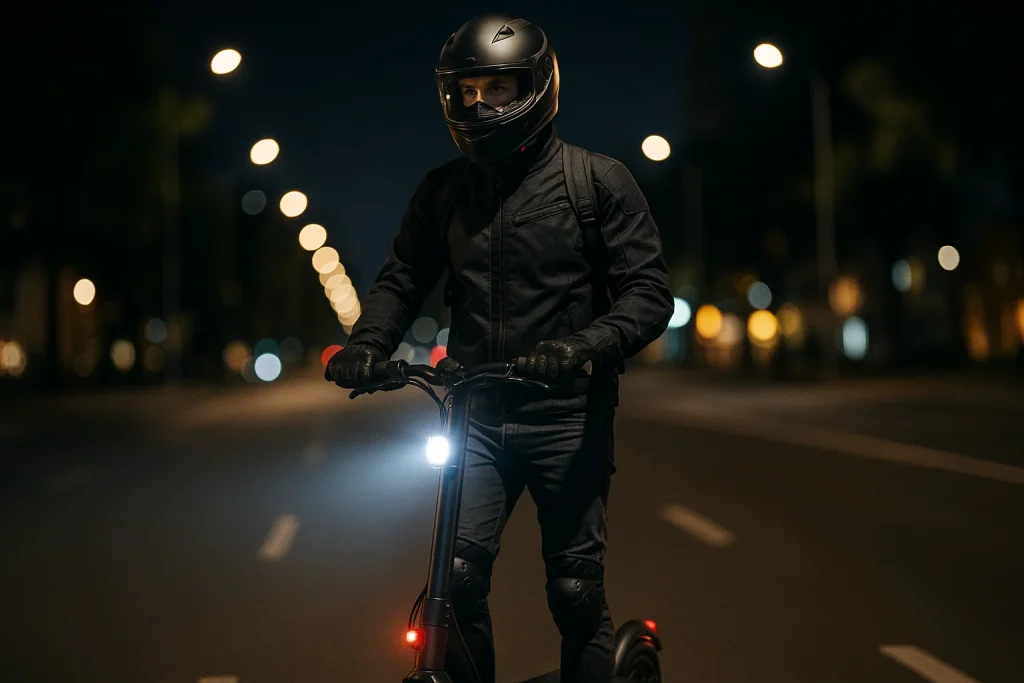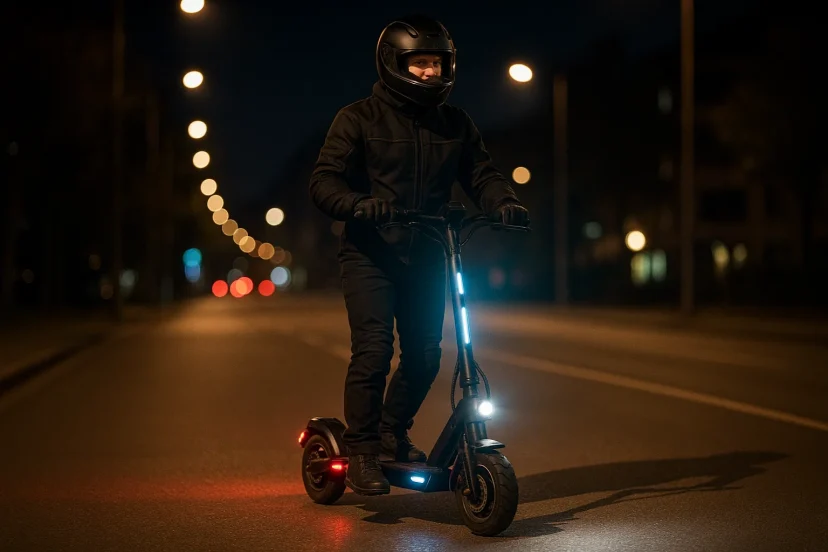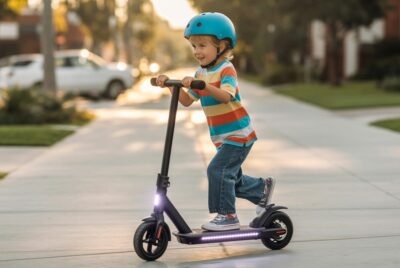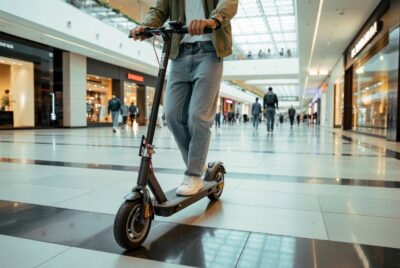E-Scooter Night Safety: Essential Tips for Safe Riding
*We may earn a commission for purchases made using our links. Please see our disclosure to learn more.
The city lights blur past as you glide through the quiet streets, the hum of your e-scooter mixing with the distant sounds of nightlife. There’s something almost magical about riding after dark – the cooler air, the peaceful roads, the sense of freedom that comes with having the streets mostly to yourself. But that moment of serenity can quickly turn dangerous if you’re not properly prepared for the unique challenges that come with night riding.
I learned this lesson the hard way during my second week of e-scooter commuting. Racing home from a late dinner with friends, I felt confident navigating the familiar route in darkness. What I didn’t anticipate was the pothole hidden in shadow, the car that didn’t see me until the last second, and the sheer terror of realizing how invisible I was to other road users. That night changed everything about how I approach e-scooter safety after dark.
“Night riding isn’t just about seeing – it’s about being seen. The moment you understand this distinction, you transform from a potential victim to a confident night rider.”
– Urban Mobility Safety Institute
Key Takeaways
- Visibility is everything: Proper lighting and reflective gear can reduce night accident risk by up to 70%
- Speed kills in darkness: Reducing speed by 25-30% at night dramatically improves reaction time
- Plan your route: Well-lit paths with bike lanes are exponentially safer than dark side streets
- Weather awareness: Rain, fog, or wind at night multiplies all safety risks
- Emergency preparedness: Always carry backup lighting and know your emergency contacts
Recommended E-scooter Night Safety Products
1. Ascher Ultra Bright USB Rechargeable Bike Light Set
Upgrade your night rides with the Ascher Ultra Bright USB Rechargeable Bike Light Set—an Amazon's Choice pick for reliable, budget-friendly visibility. Perfectly suited for e-scooter night safety, this powerful front headlight and back taillight combo ensures you're seen from every angle. The front light packs a 2000mAh battery, while the taillight holds a 330mAh cell, both rechargeable via USB. With four lighting modes—full brightness, half brightness, slow flash, and fast flash—you can adapt to any nighttime condition. Its IPX4 water resistance, tool-free installation, and lightweight yet durable design make this light set a must-have for every scooter rider. Whether commuting on dark streets or cruising through evening trails, ride confidently with visibility that goes the distance.
- Versatile Light Modes: Choose from 4 modes (steady and flashing) for different riding environments.
- USB Rechargeable: No need for batteries—just plug in and charge for eco-friendly convenience.
- Tool-Free Mounting: Easily attach and remove lights with silicone straps—no tools needed.
- Limited Water Resistance: IPX4 rating protects from splashes, but not ideal for heavy rain.
- Rear Light Battery Size: The taillight’s 330mAh battery may require more frequent recharging.
- No Auto-On Feature: Lights must be manually activated, which may be inconvenient in low-light transitions.
When it comes to e-scooter night safety, visibility is non-negotiable—and that’s where the Ascher Ultra Bright USB Rechargeable Light Set shines. This front and rear lighting combo is built with high-powered LEDs and rechargeable batteries, offering practical lighting for nighttime riding. It features four lighting modes to suit urban roads or dimly lit trails and installs without tools, making it a breeze for anyone to set up. Lightweight and waterproof to IPX4 standards, this set is not only perfect for e-scooter users but also ideal for cyclists, hikers, and campers. Whether you’re commuting after dark or just taking a nighttime cruise, this light set ensures you stay safe, seen, and stylish.
2. OMKHE LED Reflective Vest
Stay safe and seen during night rides with the OMKHE LED Reflective Vest, designed for e-scooter night safety, running, cycling, and other low-light activities. This lightweight, USB-rechargeable vest features high-brightness LED light strips and 360° reflective coverage for maximum visibility. Choose from three light modes—steady, slow flash, and fast flash—to match any nighttime environment. With up to 12 hours of run time on just a 1-hour charge, it’s a smart, energy-efficient solution for regular riders. Adjustable straps ensure a snug, chafe-free fit for men, women, and teens, while the waterproof, breathable design keeps you cool and dry on the go. Whether you're commuting or exercising after dark, this vest offers peace of mind through superior visibility.
- 360° Visibility: Full-body LED and reflective coverage keeps you visible from every angle.
- Quick Charge, Long Runtime: Fully charges in 1 hour and runs up to 12 hours—ideal for daily use.
- Highly Adjustable Fit: Customizable shoulder and waist straps fit most body types comfortably.
- Manual Light Switching: Lights must be turned on/off manually—no automatic sensors.
- Battery Maintenance Required: Regular charging is needed to maintain performance.
- No Front Storage Pouch: Lacks pockets for carrying small items like keys or cards.
When riding an e-scooter at night, visibility is everything—and the OMKHE LED Reflective Vest is one of the most effective and affordable tools for enhancing e-scooter night safety. Equipped with ultra-bright LED light strips and reflective materials, this vest ensures 360-degree visibility in low-light or rainy conditions. It offers three light modes and a powerful rechargeable battery that lasts up to 12 hours on just a one-hour charge. Designed with breathable, lightweight material and fully adjustable straps, it fits comfortably on men, women, and teens. Whether you’re scooting through city streets or jogging before sunrise, the OMKHE vest delivers dependable safety with high-performance comfort.
3. Helmet with Integrated LED Lights
Ride safer and smarter with the Silkycasters LED Bike Helmet, specially designed for adults who prioritize e-scooter night safety and urban commuting. Featuring built-in front (9 white LEDs) and rear (8 red LEDs) lights with four modes—steady, blinking, fast blinking, and warning—the helmet enhances visibility from all directions, even in low-light conditions. Constructed with a high-density PC outer shell and EPS foam inner core, it meets both CPSC and European CE safety standards for maximum impact protection. A removable visor shields your eyes from sun glare, while moisture-wicking pads and strategically placed vents keep you cool and comfortable. Whether you're scooting, cycling, or skating, the adjustable fit and stylish design make this helmet a top-tier choice for nighttime mobility.
- Built-in LED Lights: Front and rear LEDs with 4 lighting modes provide excellent nighttime visibility.
- Certified Safety: CPSC and CE certified construction offers reliable head protection.
- Comfort-Driven Design: Includes adjustable straps, sun visor, and breathable padding for long rides.
- Battery Operated Lights: Requires regular charging to maintain brightness and function.
- Only Two Sizes Available: Limited sizing may not fit all head shapes perfectly.
- No Turn Signal Feature: Lights don’t include directional indicators for signaling turns.
With powerful LED lights built into the front and rear, riders enjoy high visibility with multiple light modes to match different conditions. This helmet is not only lightweight and stylish but also CPSC and CE certified, meaning it meets strict safety standards. Ideal for cyclists and scooter users alike, it also features a sun visor, breathable padding, and airflow vents for a cool, comfortable experience. Whether you’re commuting in the city or cruising after sunset, this helmet is a reliable companion for enhancing e-scooter night safety without compromising on comfort or style.
4. KOSKILL LED Armband (2-Pack)
Boost your nighttime visibility with the KOSKILL LED Armband 2-Pack, a lightweight and adjustable safety solution designed for runners, cyclists, and e-scooter riders alike. Engineered for e-scooter night safety, each band features ultra-bright LEDs with two lighting modes—steady and flashing—to ensure you’re seen in the dark. The rechargeable design offers up to 10 hours of flashing light on a single 40-minute charge, and the flexible fit wraps easily around arms, ankles, or even your pet. Built with IPX4 waterproof protection, it’s ready to perform in sudden rain or misty commutes. Whether you're walking the dog or cruising on your scooter, these LED armbands add visibility, safety, and peace of mind.
- Long Battery Life: Just 40 minutes of charging provides up to 10 hours of use in flashing mode.
- Multi-Use Fit: Adjustable from 20cm to 45cm—wear it on your arm, ankle, or even your pet.
- Weather-Ready: IPX4 waterproof rating makes it safe to use in rain or wet conditions.
- Limited Light Modes: Only two modes—no customizable brightness or color settings.
- Micro USB Charging: Older charging standard may not be as convenient as USB-C.
- Not for Helmet Use: Best for limbs or pets—won’t replace helmet or bike-mounted lights.
These lightweight, rechargeable bands use ultra-bright LEDs to help drivers, cyclists, and pedestrians see you clearly in low-light conditions. With two lighting modes (steady and flashing) and an adjustable strap that fits both adults and children, these armbands can be worn on your arms, ankles, or even your pet’s collar. The USB rechargeable battery offers up to 10 hours of flashing light, and the IPX4 waterproof rating ensures it performs in light rain. Whether you’re commuting, exercising, or just walking the dog, these LED bands are an affordable addition to your e-scooter night safety gear.
My Journey Into Night Riding
Three years ago, I never imagined I’d become someone who actually looks forward to riding my e-scooter in the dark. The transformation didn’t happen overnight – it was built through trial, error, and a few genuinely frightening moments that taught me respect for the unique dangers of night riding and the importance of e-scooter night safety.
My first real wake-up call came during what should have been a simple ride home from work. The streetlights in my neighborhood had been flickering for weeks, creating these eerie pockets of darkness between pools of yellow light. I was cruising at my usual daytime speed, around 15 mph, when suddenly my front wheel caught something I couldn’t see – a fallen branch that had been invisible in the shadows.
The sudden stop sent me tumbling forward, my hands scraping against the asphalt as I tried to break my fall. As I sat there, checking for injuries and nursing my wounded pride, a car passed by so close I could feel the wind from its mirrors. The driver hadn’t seen me at all, even while I was sprawled in the middle of the bike lane with my scooter’s standard lights flashing.
That night, I made three crucial decisions that would transform my approach to night riding: I would invest in proper visibility gear, I would learn to read the darkness like a map, and I would never again underestimate the unique challenges that come with riding after sunset. From that moment forward, e-scooter night safety became more than a concept — it became a mindset.
The Three Pillars of Night Safety
Pillar 1: Becoming a Beacon of Light
The first lesson I learned was that standard e-scooter lights are designed for compliance, not safety. Most factory-installed lights are barely bright enough to be legal, let alone effective at keeping you safe in real-world conditions.
My lighting transformation began with a high-powered LED headlight that could illuminate the path ahead for at least 50 feet. But here’s what I discovered: the front light is only half the equation. The real game-changer was adding a powerful rear light and multiple side-visibility elements.
I remember the first night I rode with my new lighting setup. The difference was dramatic – cars began giving me wider berth, pedestrians actually saw me coming, and I could spot road hazards before they became problems. The confidence boost was immediate and profound.
The emotional impact went beyond just feeling safer. There’s something empowering about transforming yourself from a barely visible shadow into a clearly defined presence on the road. You start to own your space rather than hoping others will notice you.
Pillar 2: Mastering Speed and Situational Awareness
Speed management became my second obsession. During the day, I was comfortable cruising at 12-15 mph on familiar routes. At night, I learned to cut that speed by at least 30%, not because I was afraid, but because physics doesn’t care about your confidence level.
The mathematics of night riding are unforgiving. Your reaction time to unexpected obstacles increases in low light, while your ability to assess road conditions decreases. Meanwhile, other road users – drivers, pedestrians, cyclists – are also operating with reduced visibility and potentially impaired judgment.
I developed what I call the “headlight rule”: never ride faster than you can safely stop within the distance illuminated by your front light. This simple principle has saved me from countless close calls with everything from potholes to cats darting across the path.
The transformation in my riding style was subtle but profound. I became more deliberate in my movements, more aware of my surroundings, and more respectful of the limitations that darkness imposes on all road users.
Pillar 3: Route Intelligence and Weather Wisdom
My third major evolution was learning to think strategically about route selection. The path I took during sunny afternoon commutes wasn’t necessarily the safest choice after dark.
I began mapping out dedicated night routes that prioritized well-lit streets, bike lanes, and areas with consistent pedestrian traffic. Sometimes this meant adding 10-15 minutes to my journey, but the trade-off in safety and peace of mind was worth every extra minute.
Weather became another crucial factor in my decision-making process. Rain transforms night riding from challenging to genuinely dangerous. Wet roads reduce traction, water on your lights reduces visibility, and other drivers become even less predictable. I learned to check weather forecasts obsessively and always have backup transportation plans for stormy nights.
The emotional journey of developing this weather awareness was interesting. Initially, I felt frustrated by the limitations – why should a little rain stop me from riding? But as I matured as a night rider, I began to see weather awareness as a form of self-respect. Choosing not to ride in dangerous conditions wasn’t giving up; it was making a smart decision that ensured I’d be able to ride safely for years to come.
Common Night Riding Challenges and Solutions
The Invisibility Problem
The most dangerous misconception about night riding is assuming that having lights means being seen. Visibility is a two-way street – you need to see obstacles and hazards, but more importantly, you need to ensure that cars, pedestrians, and other road users can see you clearly enough to react appropriately.
The solution involves creating multiple points of light and reflection on your body and scooter. This means front and rear lights, yes, but also side visibility through reflective clothing, ankle bands, or even LED strips along the sides of your scooter.
Depth Perception Difficulties
Night riding plays tricks with your depth perception. Shadows can hide potholes, while reflections can make wet pavement look like standing water. I learned to scan the road surface constantly, looking for changes in texture, color, or the way light reflects off different surfaces.
Battery Anxiety
Nothing ruins a night ride faster than your lights dying mid-journey. I developed a strict routine of checking all battery levels before every ride and carrying backup lighting. This isn’t just about having redundant systems – it’s about maintaining the confidence to ride assertively rather than tentatively.
Weather Amplification
Every weather condition becomes more dangerous at night. Light rain becomes visibility-killing mist. Gentle breezes become destabilizing gusts. Temperature drops can affect both battery performance and your own reaction times.
The Psychological Transformation

One of the most surprising aspects of my night riding journey was how it changed my relationship with urban spaces. During the day, city streets can feel crowded, rushed, and impersonal. At night, riding through the same areas became almost meditative.
There’s something profound about being one of the few people moving through a space that’s usually bustling with activity. You notice architectural details that daytime chaos obscures. You hear sounds – distant music, conversations, the hum of electrical systems – that get lost in the daytime cacophony.
But this tranquility comes with responsibility. Being one of the few vulnerable road users in a space designed for cars means you bear extra responsibility for your own safety. This realization was both sobering and empowering.
Building Your Night Riding Confidence
Start Small and Build Gradually
My advice for anyone beginning their night riding journey is to start with familiar routes during twilight hours. This gives you a chance to experience reduced visibility conditions while still having enough ambient light to feel secure.
Practice riding in well-lit parking lots or quiet residential streets before venturing onto busier roads. Use this time to test your lighting setup, experiment with different speeds, and develop your night vision skills.
Develop Your Pre-Ride Ritual
I’ve developed a comprehensive pre-ride check that I perform before every night journey. This includes testing all lights, checking battery levels, inspecting tires and brakes, and reviewing my planned route for any potential hazards or changes in road conditions.
This ritual serves multiple purposes. Practically, it ensures my equipment is functioning properly. Psychologically, it helps me transition from my daytime mindset to the more focused, alert state that night riding requires.
Learn to Read the Darkness
Night riding taught me to interpret visual cues I’d never noticed before. The way headlight beams reflect off different road surfaces can tell you about their condition. The behavior of other road users – their speed, lane positioning, signal usage – often changes at night in predictable ways.
I learned to identify the difference between well-maintained streets and those with poor lighting or road conditions just by observing light patterns and shadow formations. This skill developed gradually but has become invaluable for route planning and real-time decision making.
The Broader Impact on Daily Life
What started as a practical necessity – needing to ride safely at night – evolved into something that affected many other aspects of my life. The heightened awareness and risk assessment skills I developed for night riding began appearing in other contexts.
I became more attentive to lighting and visibility in all my evening activities. I started thinking more strategically about backup plans and emergency preparedness. The confidence I gained from mastering a challenging skill spilled over into other areas where I’d previously been hesitant to push my boundaries.
Most importantly, night riding taught me that limitations can become opportunities if you approach them with the right mindset. Instead of seeing darkness as something that prevented me from riding, I learned to see it as a different kind of riding that required different skills and offered different rewards.
Advanced Night Riding Strategies
Communication with Other Road Users
Night riding made me realize how much of road safety depends on non-verbal communication between different types of road users. During the day, eye contact, hand signals, and body language help everyone predict what others are likely to do. At night, these subtle communications become much more difficult.
I learned to be more explicit in my signaling and to use my lighting strategically to communicate intentions. For example, I’ll often flash my front light to make eye contact with drivers at intersections, or use my rear light’s strobe function to signal lane changes more clearly.
Seasonal Adaptations
Night riding changes dramatically with the seasons. Summer night rides are pleasant and comfortable, with warm temperatures and generally clear conditions. Winter night riding presents challenges with cold temperatures affecting battery performance, earlier darkness, and weather conditions that can change rapidly.
I developed different gear setups for different seasons, different route preferences based on seasonal lighting and road conditions, and different decision-making criteria for when conditions are too dangerous for night riding.
Community and Connection
One unexpected benefit of becoming a serious night rider was connecting with a community of people who share this somewhat unusual pursuit. Night riders tend to be more serious about safety, more invested in their equipment, and more willing to share knowledge and experiences.
These connections have been valuable not just for practical advice, but for the sense of belonging to a community that understands the unique challenges and rewards of moving through urban spaces after dark.
Celebrating the Small Victories
Learning to ride safely at night was full of small victories that deserved recognition. The first time I successfully navigated a challenging intersection in low light. The first rainy night when I felt completely confident in my visibility setup. The first time another night rider complemented my lighting configuration.
These moments might seem trivial to someone who’s never struggled with night riding anxiety, but they represented real progress in developing a skill that combines physical ability, risk assessment, technological proficiency, and psychological confidence.
I learned to celebrate these incremental improvements rather than focusing on how much I still needed to learn. This positive reinforcement approach helped maintain motivation during the inevitable plateaus and setbacks that come with mastering any complex skill.
Looking Forward: The Evolution Continues
Three years into my night riding journey, I’m still learning and evolving. New lighting technologies emerge regularly. My routes and preferences continue to change as I discover new areas or as urban infrastructure develops. My risk tolerance and skills continue to develop with experience.
What hasn’t changed is my respect for the unique challenges of night riding and my commitment to approaching those challenges with preparation, appropriate equipment, and realistic expectations.
The goal was never to eliminate all risks – that’s impossible when you’re sharing road space with cars while riding a small, relatively vulnerable vehicle. The goal was to manage those risks intelligently while still enjoying the unique pleasures that come with gliding through the city after dark.
Your Night Riding Journey Starts Now
If you’re reading this article, you’re probably at the beginning of your own night riding journey. Maybe you’ve had a close call that made you realize you need to take night safety more seriously. Maybe you’re considering night commuting for the first time. Maybe you’re just curious about how to expand your riding into different times and conditions.
Whatever brought you here, remember that becoming a confident night rider is a process, not a destination. Every ride teaches you something new about reading conditions, managing risks, or operating your equipment more effectively.
Start with the basics: proper lighting, appropriate speeds, and familiar routes. Build your skills and confidence gradually. Don’t rush into challenging conditions before you’ve mastered the fundamentals.
Most importantly, remember that the goal is to expand your riding opportunities safely, not to prove how brave or skilled you are. Night riding at its best should feel controlled and confident, not reckless or anxious.
The city at night is waiting for you. With the right preparation, equipment, and mindset, you can claim your place in those quiet streets and experience the unique magic that comes with moving through urban spaces under the cover of darkness.
Your journey into night riding doesn’t have to be perfect from the start. It just has to begin.
Frequently Asked Questions
Q: What’s the minimum lighting setup I need for safe night riding?
A: At minimum, you need a front light with at least 300 lumens and a rear light with at least 100 lumens. However, I strongly recommend adding side visibility elements like reflective clothing or additional lights for comprehensive 360-degree visibility.
Q: Should I ride slower at night, and by how much?
A: Yes, reduce your speed by 25-30% compared to daytime riding. This accounts for reduced visibility, longer reaction times, and the increased difficulty of spotting road hazards in low light conditions.
Q: Is it safe to ride in the rain at night?
A: Rain at night significantly increases risks due to reduced visibility, decreased traction, and impaired performance of both your equipment and other road users. Unless you have extensive experience and excellent equipment, it’s better to avoid riding in wet conditions after dark.
Q: How do I choose the safest route for night riding?
A: Prioritize well-lit streets with bike lanes or wide shoulders, consistent pedestrian traffic, and good road surface conditions. Avoid dark side streets, areas with poor lighting, and routes with heavy car traffic but no dedicated cycling infrastructure.
Q: What should I do if my lights fail during a night ride?
A: Always carry backup lighting – at minimum, a small flashlight or phone light. If your primary lights fail, reduce speed immediately, move to the safest available position (sidewalk if legal and safe), and use your backup lighting to make yourself visible while you address the problem or arrange alternative transportation.
















